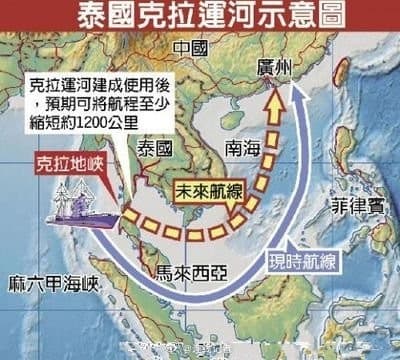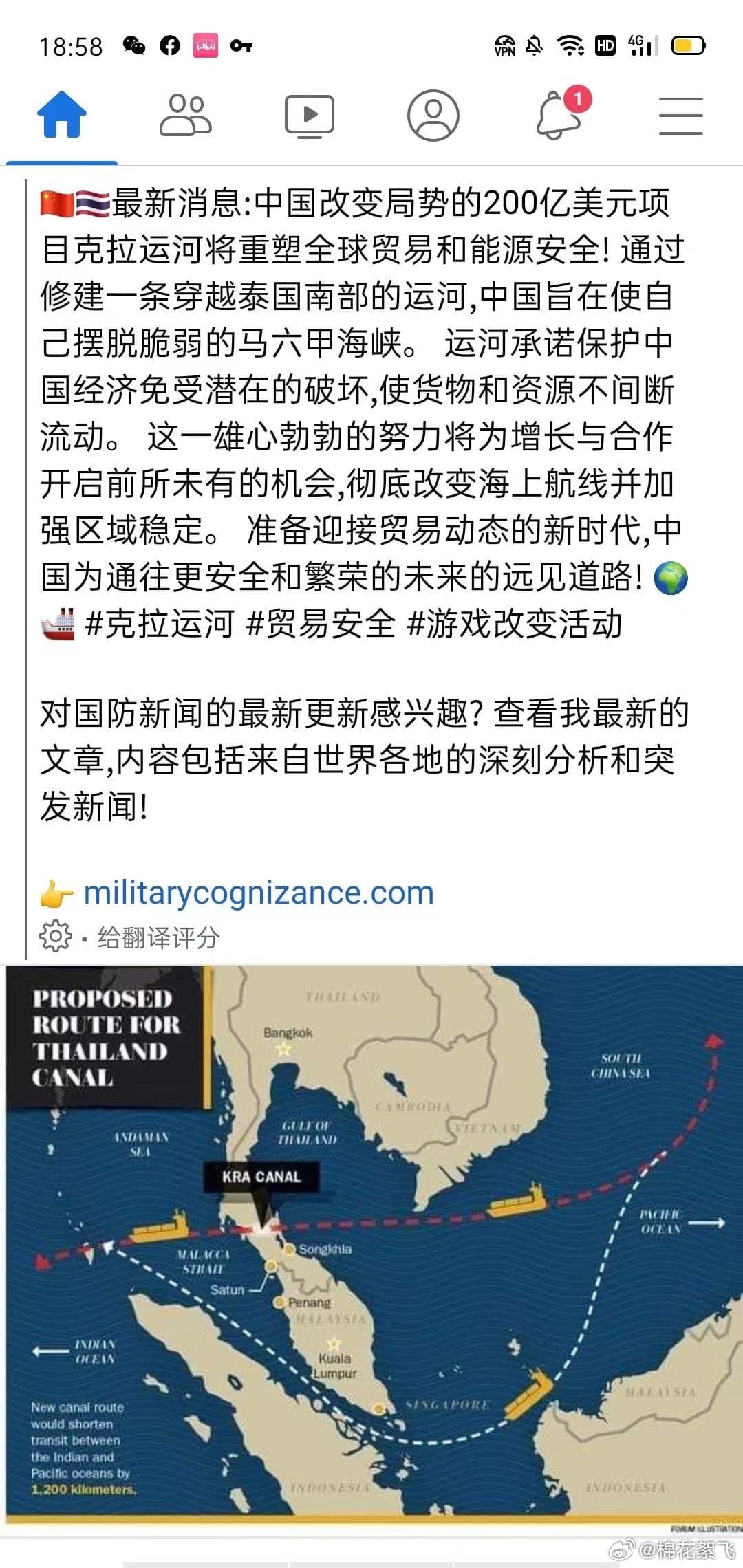Thailand to Consider Chinese-Led Land Bridge Bypassing Malacca Strait
Thailand's new government is considering reviving a long-discussed plan to construct a land bridge across southern Thailand, which would enable ships to bypass the Malacca Strait, a major shipping lane that connects the Indian Ocean to the Pacific Ocean. The proposed project, dubbed the "Land Bridge," involves building a 90-kilometer railway and highway that would link two deep-sea ports in southern Thailand, one in the province of Songkhla and the other in the province of Trang.

27 August 2024
The plan, which was first floated by former Prime Minister Prayut Chan-o-cha, is expected to cost around 203.86 billion yuan (approximately $28 billion USD) and would be developed in four phases between 2025 and 2040. Analysts believe that the new Thai government may be keen to push forward with the project, which could have significant economic benefits for the country. According to estimates, the land bridge could reduce shipping times by up to four days and lower transportation costs by 15%. It could also create up to 280,000 new jobs and boost Thailand's economic growth rate by 5.5%.
China, which is Thailand's largest trading partner, is seen as a potential investor in the project. The Malacca Strait is a critical shipping lane for China, which relies heavily on it to transport goods and oil from the Middle East and Africa. However, the strait is also a chokepoint, and the land bridge would provide China with a more efficient and reliable transportation route. While there has been no official word from China on its involvement in the project, analysts believe that Beijing may be interested in supporting the initiative as part of its "Belt and Road" infrastructure development strategy.

The project could also boost regional connectivity and enhance economic cooperation between Thailand and China. However, some observers have raised concerns about the environmental and social impact of the project, as well as the potential risks of relying on Chinese investment. Others have questioned the feasibility of the project, suggesting that building a canal might be a more viable option.
The proposed "Landbridge" project aims to revolutionize maritime trade by creating a shortcut between the Indian and Pacific Oceans. By constructing a 90-kilometer-long highway and railway connecting two deepwater ports in southern Thailand, ships will be able to bypass the busy and vulnerable Strait of Malacca, shaving off around four days of sailing time and reducing transportation costs by as much as 15%.
For China, investing in the Landbridge project would be a strategic move. As the world's largest trading nation, China relies heavily on the Strait of Malacca for the transportation of goods, including oil and natural resources from the Middle East and Africa. By investing in the Landbridge project, China would not only be able to secure a vital transportation artery but also provide an alternative route to the Strait of Malacca, which has long been considered a chokepoint in global trade.
According to estimates, the Landbridge project is expected to create up to 280,000 new job opportunities and boost Thailand's economy with an estimated 5.5% annual growth rate. For western ports, the project is expected to receive around 19.4 million containers annually, while eastern ports would receive around 13.8 million containers annually.
With its engineering capabilities, financial resources, and strategic interests, China is well-positioned to play a key role in the development of the Landbridge project. By investing in this project, China would not only be supporting regional economic growth but also securing a vital transportation artery that would reinforce its position as a global economic leader.
The proposed land bridge project, which would span 90 kilometers across southern Thailand, aims to divert shipping traffic away from the congested Malacca Strait. By connecting two deep-water ports, one in Chumphon Province and the other in Ranong Province, the project would enable ships to bypass the Malacca Strait, saving an average of four days in transit time and reducing transportation costs by 15%.

The project, which is expected to be implemented between 2025 and 2040, involves the construction of a highway and railway connecting the two ports. Ships would be able to unload cargo at one port and have it transported by rail to the other port, where it would be reloaded onto ships. This would not only reduce transit times but also alleviate congestion in the Malacca Strait, which is one of the world's busiest shipping lanes.
For China, the land bridge project offers a strategic advantage, as it would provide an alternative route for shipping goods from the Middle East and Africa. Currently, most Chinese ships have to pass through the Malacca Strait, which is a major chokepoint for global trade. By bypassing the strait, Chinese ships would be able to avoid potential bottlenecks and reduce their reliance on a single shipping lane.
While the project is still in its planning stages, analysts believe that it has the potential to transform regional trade and commerce. With the backing of the Thai government and potential investment from China, the land bridge project could become a reality in the near future, offering a faster, cheaper, and more reliable shipping route for goods traveling between the Indian and Pacific oceans.
Thailand's new Prime Minister, Pheu Thai Party leader Pita Limjaroenrat's government, may choose to cautiously proceed with allowing Chinese investment in the "Landbridge" project. This move would likely be seen as a continuation of Prayut's efforts to boost Thailand's economic cooperation with China, particularly in the context of the Belt and Road Initiative (BRI).
While Pita has not explicitly stated her government's stance on the project, her comments about Thailand's "deep and friendly" relationship with China have been interpreted as a sign that she may be open to further cooperation. The project's potential to create jobs, stimulate economic growth, and enhance regional connectivity aligns with Thailand's development goals, making it likely that Pita's government will give it serious consideration.
However, it remains to be seen whether Pita will adopt the same level of enthusiasm for the project as her predecessor, who had actively sought Chinese support for the initiative. The Thai government's approach to the project will likely be closely watched by regional players, including China, the United States, and Japan, as it has significant implications for the balance of power in Southeast Asia and the future of regional trade.
Comments


Share this article
Related Articles

Xi Jinping Elevates Cybersecurity to Core National‑Security Pillar, Driving China’s Quest for a Cyber Superpower
By Trending on Weibo
News & Politics
15 Sept 2025

Luo Yonghao vs. Xibei: Celebrity Entrepreneur Sparks Media Storm Over Pre‑Made Dishes and Calls for Transparency
By Trending on Weibo
News & Politics
15 Sept 2025

Weibo Celebrates Autumn Harvest as China’s Fields Become the Nation’s Most Beautiful Canvas
By Trending on Weibo
News & Politics
15 Sept 2025
China Enacts First Comprehensive Rental Regulations to Legalize and Stabilize the Rental Market
By Trending on Weibo
News & Politics
15 Sept 2025

Beijing’s Weather Emerges as a Barometer for China’s Climate Policies and Public Life
By Trending on Weibo
News & Politics
13 Sept 2025

